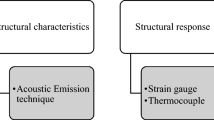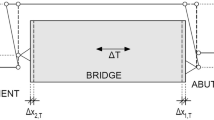Abstract
A novel monitoring scheme oriented towards the structural examination of reinforced concrete slabs subject to railway traffic action is presented. Monitoring is based on the measurement of the mean axial strain profile variation in the cross-section of the slab. The strain profile is reconstructed under the assumption of plane sections by measuring the variation of two distances between two pairs of points materialized at two different levels under the slab on rigid attachments fixed on the slab. The distance variations are measured by means of strain gages measuring the deformation of two very thin strips connecting the two attachments. The implementation of the above scheme on a short-span railway bridge for a period of 7 months and the processing of the acquired signals are presented in detail. Some interesting monitoring records are provided over which the efficiency of the proposed scheme is discussed.










Similar content being viewed by others
Abbreviations
- ε :
-
Strain
- ε train max, d :
-
Maximum strain recorded on a reinforcement bar during the passage of a train according to the direct method
- ε train max, ind :
-
Maximum strain at the level of the reinforcement during the passage of a train according to the indirect method
- EMI:
-
Electromagnetic interference
- FFT:
-
Fast Fourier transform
- RC:
-
Reinforced concrete
- ULS:
-
Ultimate limit state
References
Treacy MA, Brühwiler E (2015) Action effects in post-tensioned concrete box-girder bridges obtained from high-frequency monitoring. J Civil Struct Health Monit 5(1):11–28
Brühwiler E, Bosshard M, Steck P, Meyer C, Tschumi M, Haldimann S (2013) Fatigue safety examination of a riveted railway bridge using data from long term monitoring. In: IABSE Symposium Report; vol 99, No 25, pp 477–484
Rodrigues JFS, Casas JR, Almeida PAO (2011) Fatigue-safety assessment of reinforced concrete (RC) bridges: application to the Brazilian highway network. Struct Infrastruct Eng 9(6):601–616
Leander J, Andersson A, Karoumi R (2010) Monitoring and enhanced fatigue evaluation of a steel railway bridge. Eng Struct 32(3):854–863
Catbas FN, Susoy M, Frangopol DM (2008) Structural health monitoring and reliability estimation: long span truss bridge application with environmental monitoring data. Eng Struct 30(12):2347–2359
Frangopol DM, Strauss A, Kim S (2008) Bridge reliability assessment based on monitoring. J Bridge Eng 13:258–270
Kenel A, Nellen P, Frank A, Marti P (2005) Reinforcing steel strains measured by Bragg grating sensors. J Mat Civil Eng 17(4):423–431
Casas JR, Cruz P (2003) Fiber optic sensors for bridge monitoring. J Bridge Eng 8(6):362–373
Li HN, Li DS, Song GB (2004) Recent applications of fiber optic sensors to health monitoring in civil engineering. Eng Struct 26(11):1647–1657
Hilleerborg A (1983) Analysis of a single crack. In: Wittmann FH (ed) Fracture mechanics of Concrete. Elsevier, Amsterdam, pp 223–249
Treacy MA (2014) The use of monitored data in the verification of structural and fatigue safety of existing post-tensioned concrete highway bridges. Dissertation, Lausanne: Ecole Polytechnique Fédérale de Lausanne
Morant A, Wisten A, Galar D, Kumar U, Niska S. (2012) Railway EMI impact on train operation and environment. In: Proceedings of the 2012 international symposium on electromagnetic compatibility (EMC EUROPE), Rome, Italy, Sept. 17–21 2012
Niska S. (2008) Measurements and analysis of electromagnetic interferences in the Swedish railway systems. Dissertation, Luleå University of Technology, Luleå
Connolly DP, Kouroussis G, Laghrouche O, Ho CL, Forde MC (2015) Benchmarking railway vibrations—track, vehicle, ground and building effects. Constr Build Mater 92:64–81
Pasquier R (2015) Performance assessment and prognosis for civil infrastructure based on model falsification reasoning. Dissertation, Ecole Polytechnique Fédérale de Lausanne, Lausanne
Acknowledgments
The authors are grateful to Mr. Gilles Guignet of EPFL for his contribution in designing and implementing the monitoring system. They are also grateful to the Swiss Federal Railways for the permission to monitor the underpass. This work has been financially supported by VALE international SA, CH-1162 Saint-Prex; Grant No 520.222.
Author information
Authors and Affiliations
Corresponding author
Rights and permissions
About this article
Cite this article
Grigoriou, V., Brühwiler, E. Monitoring of strain profile variations in the RC slab of a short-span railway bridge. J Civil Struct Health Monit 6, 587–601 (2016). https://doi.org/10.1007/s13349-016-0175-6
Received:
Revised:
Accepted:
Published:
Issue Date:
DOI: https://doi.org/10.1007/s13349-016-0175-6




